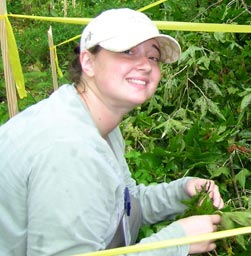Colleen Iversen
Wesely Award Winner Sees the Forest for its Trees

2007 Wesely award winner Colleen Iversen examines one of her plots in the sweetgum forest. Iversen's research considers how excess carbon dioxide affects plants.
As the amount of heat-trapping gases such as carbon dioxide (CO2) rise in the atmosphere due to fossil fuel burning, forests have been seen as critical to the absorption of CO2 emissions. However, research that University of Tennessee doctoral student and Wesely award winner Colleen Iversen is pursuing indicates that carbon storage in forests might be more complicated than was once thought.
The prevailing view amongst scientists has been that most excess carbon taken up by forest ecosystems would be allocated to the woody portion of the tree. However, in the sweetgum plantation at Oak Ridge National Laboratory’s (ORNL) forested Free-Air CO2 Enrichment (FACE) experiment, Iversen has found that a significant amount of the excess carbon taken up by the trees goes to forming fine roots, which are smaller in diameter than the thickness of a penny. This phenomenon can lead to a decline in soil nutrients that may prevent forests from continuing to take up more carbon in response to rising atmospheric CO2.
The main research objective at ORNL FACE is to understand and to quantify how greater CO2 emissions might affect the Eastern deciduous forest. Iversen and the other researchers at the ORNL FACE facility have identified several important implications for forest responses to elevated CO2.
First, less carbon may be stored as living tree matter than originally thought because fine roots live and die in the span of a year, whereas stem wood can last for the lifespan of the tree (greater than 50 years). Increased root production also leads to increased nitrogen uptake from the soil. Because the soil contains a finite pool of nitrogen, researchers are uncertain as to how long this imbalance can be sustained.
Finally, decomposition of the added roots results in a greater nitrogen requirement for the microbes that degrade them. While this could lead to less nitrogen available for plants, it could also result in more carbon storage in the soil.
“The way in which forests allocate biomass [living matter] in response to rising atmospheric concentrations of CO2 will determine whether carbon storage in forests will mitigate some portion of fossil fuel burning,” Iversen explained.
Iversen’s research at ORNL has spawned collaboration with scientists at Argonne National Laboratory to explore the relationship between decomposing roots and carbon storage in soil organic matter.
In recognition of Iversen’s research, her use of ORNL facilities, and her collaborative efforts with her ORNL research mentor, Iversen received a 2007-2008 Marvin L. Wesely Distinguished Graduate Research Environmental Fellowship (GREF). Presented annually by DOE’s Office of Biological and Environmental Research-Climate Change, the award will provide distinction and visibility to Iversen’s research.
